Humans, when we consider space travel, recognize the need for gravity. Without our planet, is artificial or antigravity even possible?

- Here in our Universe, under general relativity, everything that has mass or energy seems to both cause and also to respond to the curvature of spacetime, rendering gravity an always attractive force.
- And yet, when we think about science fiction, from Star Trek to Battlestar to 2001, artificial gravity and even antigravity are ideas that have permeated our culture in film, literature, television, and more.
- Is this even something that’s physically possible? Or do the rules of general relativity absolutely forbid something like this from becoming reality? Physics investigates.
For as long as we’ve been thinking about journeying to other star systems and the planets and worlds that orbit them, we’ve been compelled to consider just how to keep human beings intact during any journey that would bridge the interstellar distances. While short trips through the zero-gravity environment of space might be feasible for humans, over longer time periods, human bodies suffer from all sorts of maladies: space blindness, bone density loss, muscle atrophy, and much more. While instantaneous teleportation or faster-than-light travel, either through a wormhole or via warp drive, might be satisfactory solutions for science fiction, when it comes to reality, we need a superior plan.
What sorts of options are there, either for antigravity or for artificial gravity, if we want to make such a solution realistic and feasible? Are there any that don’t violate the laws of general relativity themselves? That’s what Steven Fredman wants to know, asking:
“Antigravity and non-rotational artificial gravity have been a staple of science fiction for years. But if general relativity is correct (as it certainly seems to be), is anti-/artificial even theoretically possible? As I understand it, gravity is a manifestation of the curvature of spacetime. Could locally altering the shape of spacetime produce antigravity?”
These are two different questions, about artificial gravity and antigravity, but their answers are intimately related. Here’s what the underlying laws of physics have to say.
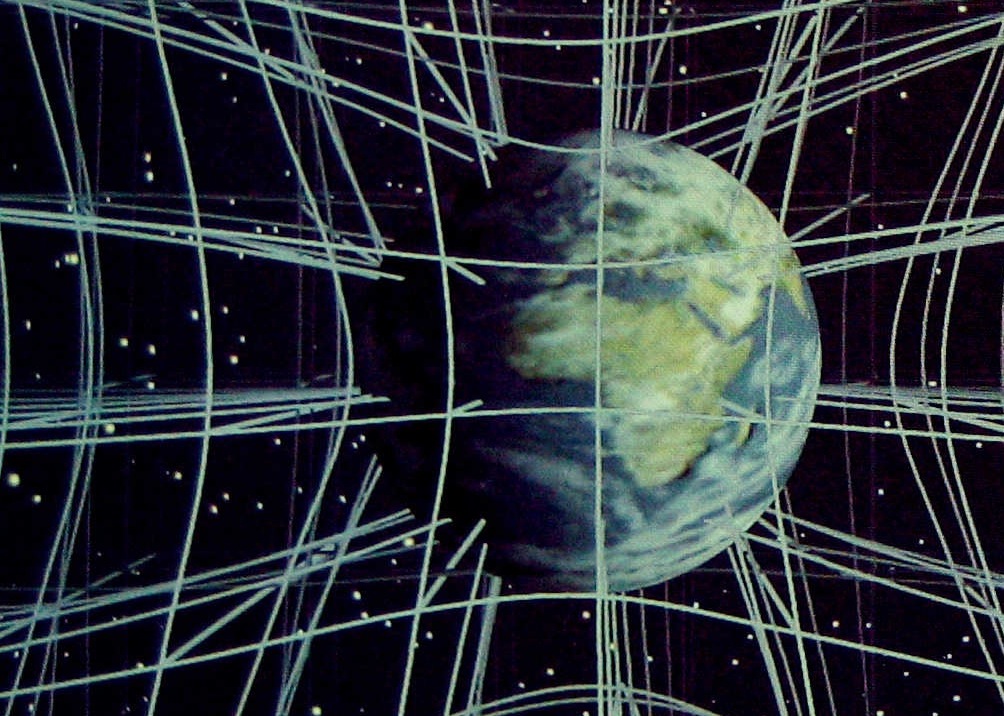
When it comes to gravity, the way it works is straightforward, if not necessarily simple: the presence of matter and energy causes the fabric of spacetime to curve, and that spacetime curvature, in turn, determines the paths that matter and energy will be compelled to follow with the passage of time. Here on Earth, the enormous amount of mass (6 × 1024 kg) all compressed into the same relatively small volume (a spheroidal shape with a radius of 6371 km) means that any massive object near our planet’s surface experiences a certain acceleration downward, toward Earth’s center: 9.8 m/s², also known as 1g.
This is the amount of acceleration, due to gravity, that human beings and a long line of our ancestors have adapted to over innumerable generations, and it is roughly the amount we’d need to maintain along our journey through space in order to prevent our bodies from degrading along any sort of substantial interstellar journey. While the technologies we’d most desire, including:
- instantaneous teleportation,
- safe travel through a wormhole,
- or warp drive,
would all be transformative, they seem to require something that doesn’t exist within this Universe, at least as we understand it today: some form of negative energy. With such a technology in hand, many of our most pressing space travel problems would instantly be solved.

It’s long been known that some sort of negative energy would be required to make warp drive work, as negative energy — at least, from a gravitational perspective — would be the thing required to “reverse curve” space in the opposite fashion that positive mass/energy induces a curvature to space. Unfortunately, every entity that we know of in the universe, from all the fundamental particles found within the Standard Model to the zero-point energy of empty space itself, contains only a net positive amount of energy, with negative energy solutions not being physically admissible, or represented in reality, at all.
There was some hope that, despite the fact that it requires positive energy to create (via E = mc²), antimatter might somehow anti-gravitate instead of gravitating the same way that normal matter does. This would necessitate that instead of having inertial mass (the m in Newton’s F = ma) be equal to gravitational mass, which is true to at least 15 significant digits for normal matter, that antimatter would have to have its inertial mass equal the negative of its gravitational mass. This wasn’t something that would have been expected by conventional theories, but in an experiment performed last year at CERN, the ALPHA-g experiment, they were able to successfully create neutral anti-atoms and observe which way (and which rate) they fell at in Earth’s gravitational field. For the first time, we had experimental validation: antimatter gravitates as normal, rather than not gravitating or anti-gravitating.
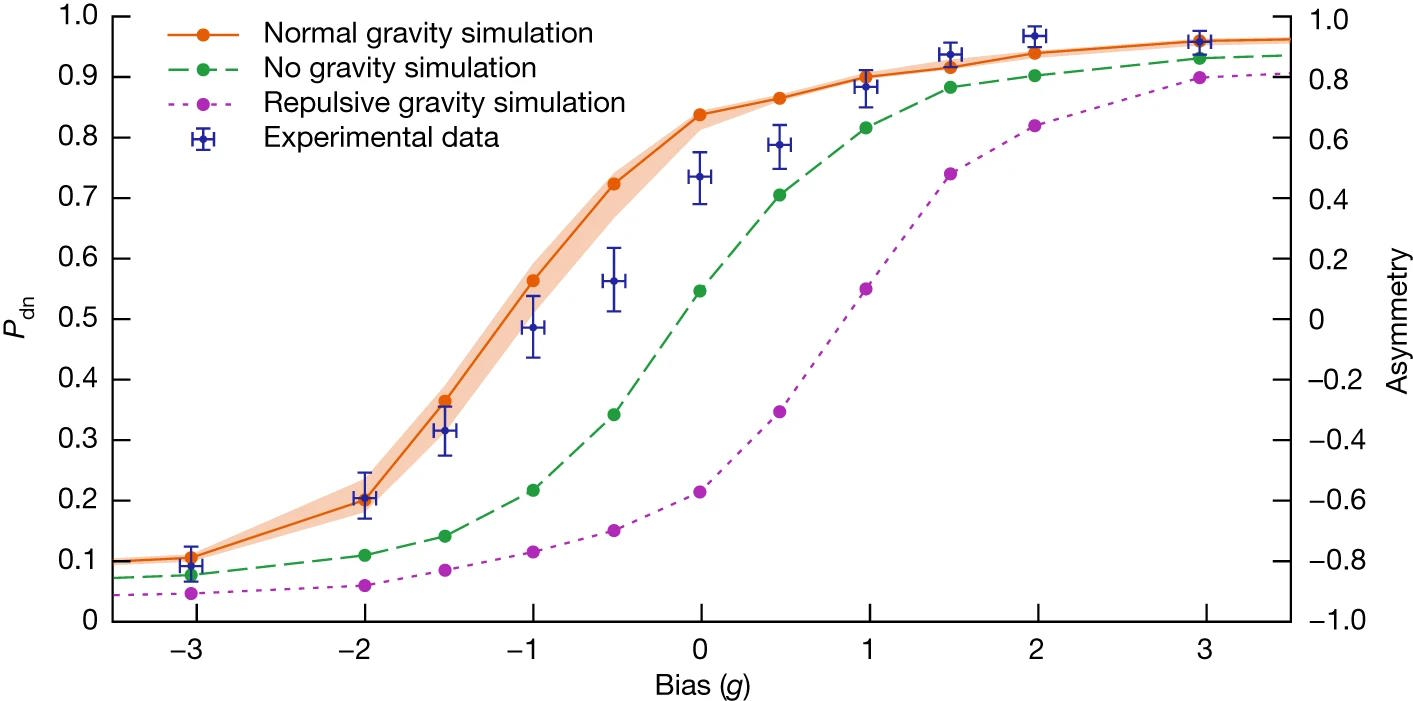
The notion of antigravity is very popular because of all of the things it would suddenly enable. For example, one of the simplest but most powerful electromagnetic devices known is the capacitor. The way a capacitor works, in its simplest form, is that you have two large-area, conducting surfaces that are very close to one another. In order to leverage its electromagnetic properties, you have to charge up these two conducting surfaces: where one of them will be given a positive net electric charge and the other will be given an equal-and-opposite amount of negative net electric charge. It doesn’t really matter what the shape of your capacitor is, whether it’s:
- two spherical shells separated by a small gap,
- two cylinders that nest inside of one another, again separated by a small gap,
- or two parallel plates that have a small gap between them.
In all of these cases, the important aspect is that there’s a large amount of charge of one species, distributed over an area, on one “side” of the capacitor, with an equally large amount of charge of the opposite type, distributed over a comparable area, on the other “side” of the capacitor. Because we have these two fundamentally different, opposite types of charges, this creates an electric field between the two plates of the capacitor. Any other charged particle that we place in that region of space — between the plates or whatever surfaces possess these charges — is going to accelerate: either away from the positively charged side and toward the negatively charged side if the particle has a positive charge, or in the opposite direction if the particle has a negative charge.
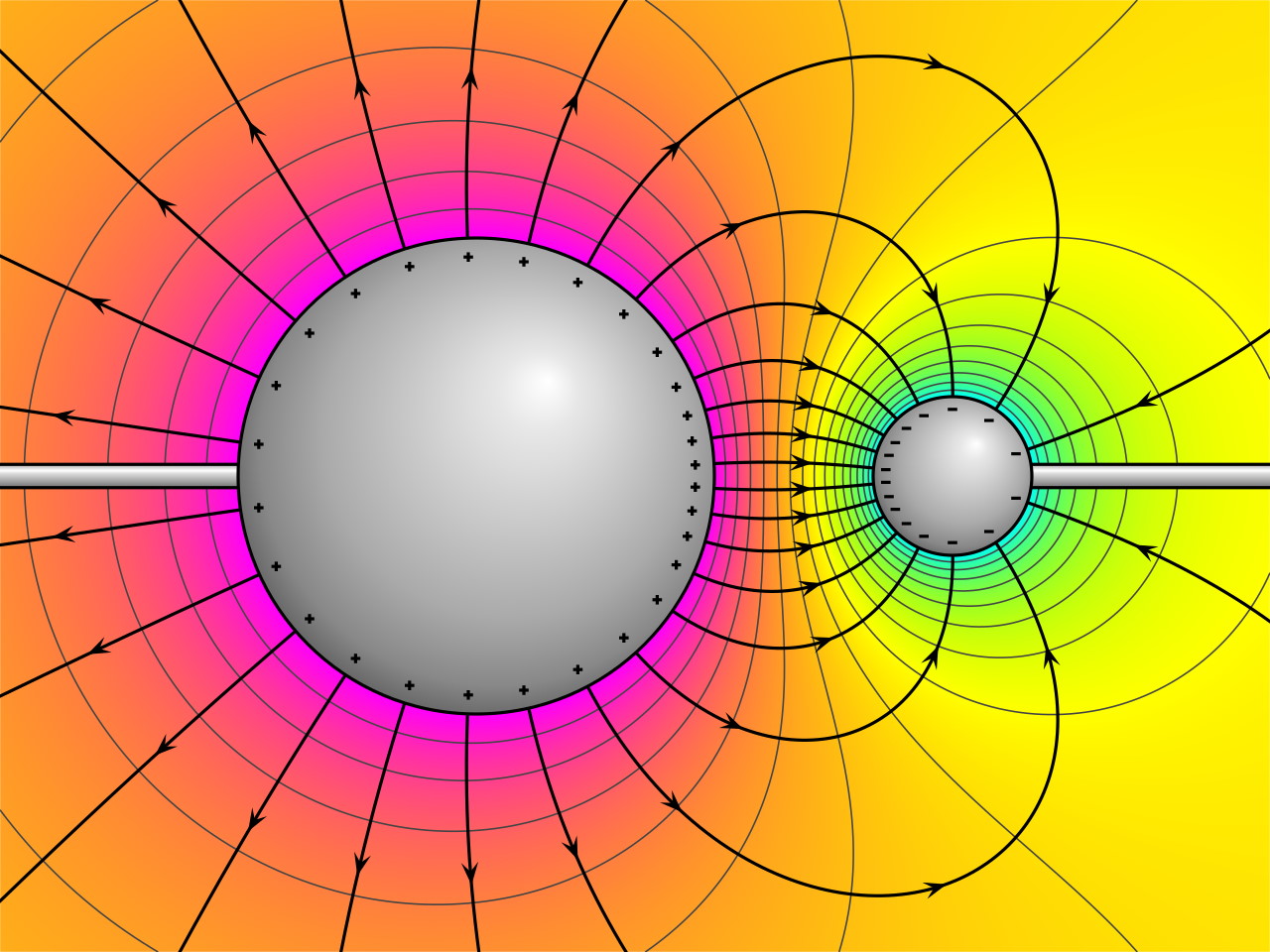
If gravity worked the same way that electromagnetism did, it would be a very straightforward exercise to create some sort of “gravitational capacitor” in direct analogy. You’d simply put your gravitating material down on the floor of your spacecraft, along with an equal-and-opposite amount of your anti-gravitating material down on the ceiling of your spacecraft, and any mass — including a human — would be attracted down toward the positively-gravitationally-charged floor and repelled away from the negatively-gravitationally-charged ceiling. If there were some sort of negative mass that we could harness and manipulate, designing an antigravity spacecraft like this would be child’s play.
But that isn’t reflective of the Universe we have and inhabit at all. Gravity, unlike electromagnetism, only has one type of charge: positive mass and/or positive energy. Without some type of negative mass and/or negative energy entity, we can’t create a directed gravitational field the way we can direct and control an electric field. The only option we have, if we want to create positive gravity, is to do it the old fashioned way: to gather enough mass into one location so that its gravitational pull provides you with the acceleration you desire. Unfortunately, this would mean needing a spaceship roughly the size and mass of planet Earth itself in order to make interstellar travel a reality, and that’s not exactly practical, either.

There’s an important reason that antigravity shouldn’t be a physically realistic possibility in this Universe: a theoretical reason that’s even more compelling than any experimental data we can collect. Physicists often give this reason a fancy name — an energy condition — but even though its mathematical definition is esoteric, its physical meaning is very straightforward.
Imagine that you have a Universe that’s very much like ours: we have quantum particles, all of which have either positive mass or are massless and carry positive energy, and we have quantum fields that permeate the Universe. Now, imagine one slight difference: the total amount of energy inherent to space, everywhere and at all times, is no longer necessarily restricted so that it can’t be negative.
If this were the case, then suddenly antigravity — or negative gravity — really would be possible. In any one particular region of space, you could extract particles (and antiparticles) out of it, through some means like the Schwinger effect, and you wouldn’t be limited by the amount of energy that the space itself already possessed. In fact, you could keep extracting particles (and antiparticles) as much as you liked, and because you didn’t forbid these negative energy states on physical grounds, you could create as large of a negative energy density as you like by continuing to extract particles and antiparticles: stealing energy from space itself by making more masses via E = mc².

This scenario, as attractive as it might seem, would be pathological for physics. In our Universe, things always tend toward the ground state, or the lowest-energy state that it’s possible for them to occupy. This is true of electrons in atoms, it’s true of balls that roll down hills, and it’s true of quantum fields themselves.
If you have a quantum field that possesses a large amount of energy, it will spontaneously transition down to a lower energy state, possibly creating new particle-antiparticle pairs in the process (and shedding energy) in order to get there. If negative energy states were allowed — if there were no bounds on how “low” in energy empty space could get — then any state of the Universe where empty space existed at all (i.e., a vacuum state) would be inherently unstable. It would decay, in a quantum fashion, to a still lower-energy state by emitting particles (and antiparticles) at will. It would keep doing so, eventually producing an infinite number of particles with a cumulative amount of infinite energy, all while the vacuum state continued to drop lower and lower without any restrictions.
This has far-reaching implications for cosmology, including physically forbidding many examples of dark energy where it increases in strength over time. Simply put, you can’t have a spacetime where the total energy in it becomes negative, and that means you can’t have antigravity in our Universe in a physically realistic sense.
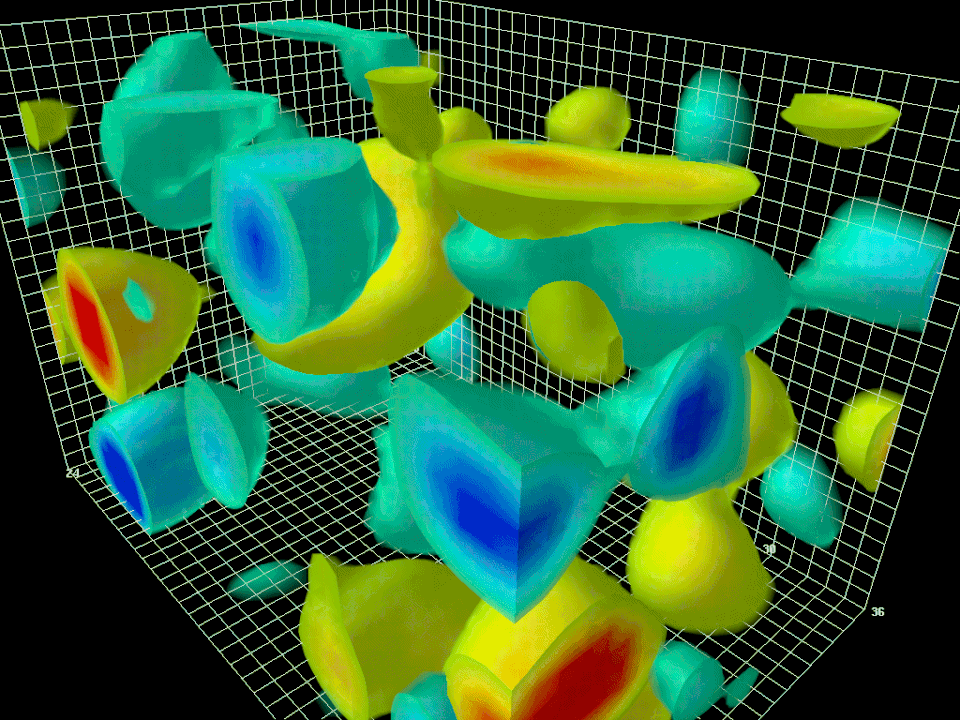
Sure, you can perform some sort of party trick that makes the energy of space effectively negative in some small region, but you have to rig your system in a very special way. For example, you could:
- fill all of space with a massive, energy-containing fluid,
- then put a mass within it that has even greater mass/energy density than that fluid,
- and then create “bubbles” of vacuum within that fluid,
- and those bubbles will then behave as though they are regions of space with negative mass/energy.
However, this is a trick, as those regions only have “negative” mass/energy compared to the artificially inflated average energy density you created by putting that massive fluid down in space in the first place.
Since space itself — even in its deepest, lowest-density, intergalactic depths — only has an energy density that’s about the equivalent of one proton per cubic meter, or about 1-part-in-1030 as dense as liquid water, you’d need to empty out thousands of cubic light-years worth of space of all quantum particles just to create one “anti-Earth’s” worth of negative effective mass. Not only is this not feasible to do, from a practical point of view, but it’s woefully insufficient to create the magnitudes of antigravity that would keep a human safe. As a result, we have to look to a different set of methods if we want to have humans traveling through space with some sort of equivalent-to-gravity experience: artificial gravity.

Einstein was someone who had an awful lot of thoughts and ideas over the course of his life, but his “happiest thought” was something that came to him when he was considering the problem of gravitation back in 1907. He wanted to know what the difference was between:
- someone who was accelerating due to an external force, like the thrust from an engine,
- and someone who was accelerating due to the force of gravity, like on the surface of Earth.
Einstein’s big revelation was that there would be no difference: the two situations would be physically equivalent to one another. This became known as Einstein’s equivalence principle, and working out the mathematical footing of it was what led directly to the theory of general relativity.
This means, if you were to maintain a constant acceleration for your spacecraft — either through linear acceleration from constant thrust or through rotational acceleration in the form of spinning at a constant speed — a human on board would actually be able to experience that vaunted “1g” of acceleration throughout their entire journey. Unfortunately, the amount (and mass) of fuel required for constant linear acceleration is completely prohibitive even for an interstellar journey to the closest star system beyond our own, even if we were to use 100% efficient antimatter fuel. (And our question-asker forbade us from considering rotational options, such as the spinning station from 2001: A Space Odyssey or some structure like an O’Neill cylinder.)
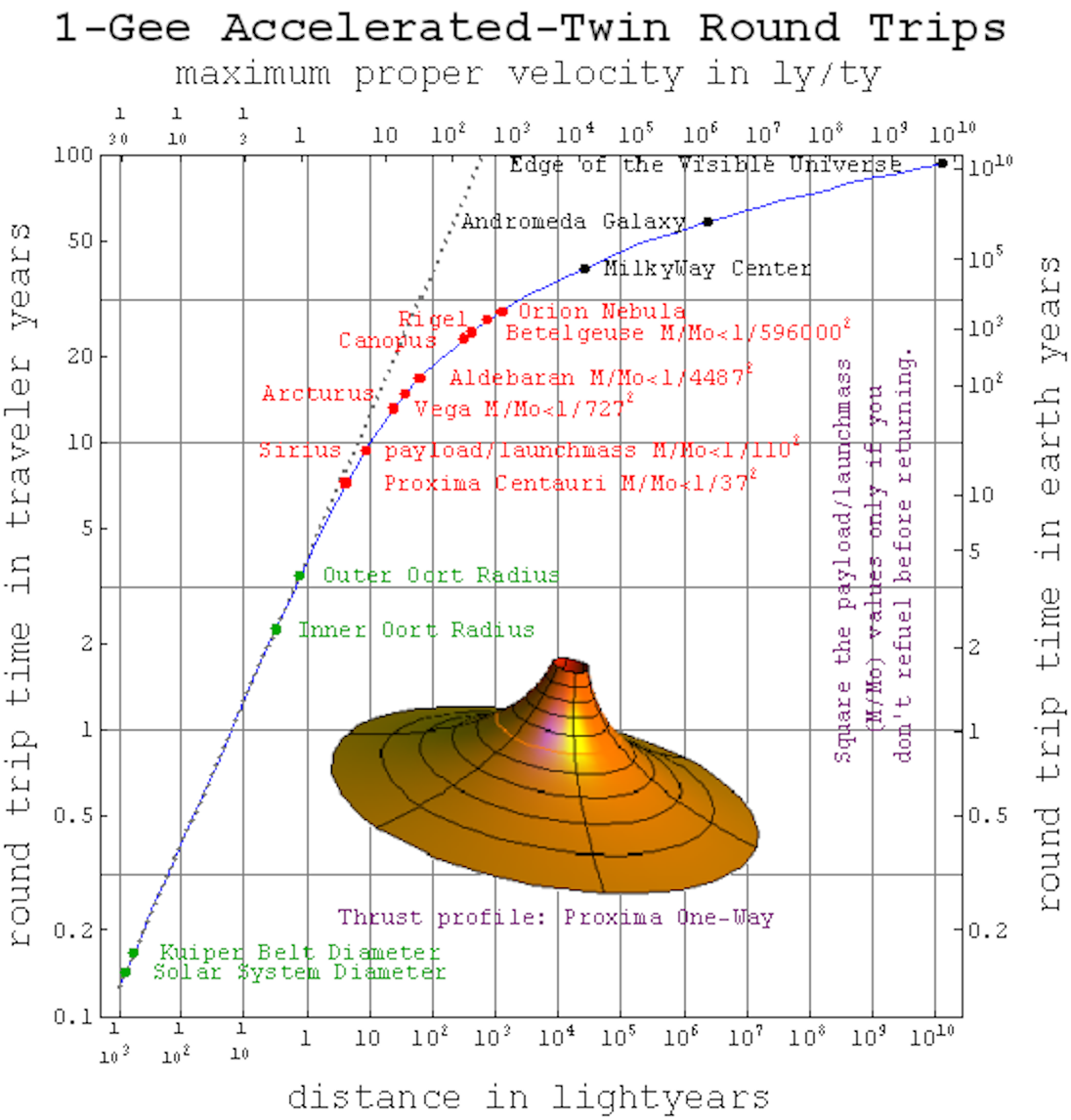
Now, it’s very important to recognize an extremely important caveat that applies to pretty much anything we’d ever say: all of this assumes that the laws of physics, as we understand them today, are actually representative of what the laws that govern our physical Universe actually are. It may turn out that:
- some sort of negative mass/energy is possible,
- that the inviolable energy conditions that govern our Universe can in fact be violated,
- that general relativity and/or quantum field theory will be superseded by a theory where antigravity is allowed,
- or that we actually can have negative energy states in space in a way that we currently think is forbidden.
If you can change the rules, you can change the set of possible outcomes that are allowed, and we have no way of knowing where or how our current laws of physics, when we reach their limits, are eventually going to break down.
But if we assume that the laws of physics as we know them actually hold true in this regime where we’re asking about them, then no, antigravity is not possible. Artificial gravity, however, simply through the power of mundane acceleration, is very much still allowed, and that would be the preferred scenario for maintaining an acceleration of “1g” for everyone — human and non-human — on board a spacecraft that took an interstellar journey. Until we implement such a solution, however, we’re not only going to have human spaceflight be restricted to travel within our own star system, but astronauts will continue to suffer from maladies resulting from reduced gravity, microgravity, or zero-gravity environments. Those problems, rather than violations of various energy conditions, should probably be our first order of business for the long-term health of space travelers.


